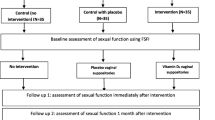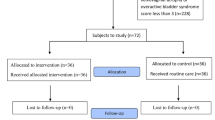Abstract
Introduction and hypothesis
Genitourinary syndrome of menopause is a major health concern in postmenopausal women. This study was aimed at comparing the effect of a vitamin E vaginal suppository with that of conjugated estrogen vaginal cream on sexual function in postmenopausal women with genitourinary syndrome of menopause.
Methods
This survey was carried out on 52 postmenopausal women aged 40–65 years who had been referred to gynecology clinics in Mashhad city, during 2013–2014. Keeping β = 0.1, the power was calculated to be 90%. The patients were randomly divided into two groups: vitamin E vaginal suppository and conjugated estrogen vaginal cream. Participants used the medications for 12 weeks. They were visited at the 4th, 8th, and 12th weeks. Validated Abbreviated Sexual Function Questionnaire (ASFQ), as the primary outcome measure, and a demographic information questionnaire, were used to collect data at each visit. Data were analyzed using SPSS and p < 0.05 was considered statistically significant.
Results
Mean overall scores of the ASFQ were increased significantly in both groups during the course of the study, compared with baseline (p < 0.001). However, the mean ASFQ scores of the two treatments did not differ significantly.
Conclusion
Improved scores of ASFQ after the 12th week showed that the treatment was successful in both groups. Therefore, a vitamin E vaginal suppository may be an alternative to vaginal estrogen in relieving the symptoms of vaginal atrophy in postmenopausal women, especially those not able to use hormone therapy or have low compliance.

Similar content being viewed by others
References
Thompson WK, Charo L, Vahia IV, Depp C, Allison M, Jeste DV. Association between higher levels of sexual function, activity, and satisfaction and self-rated successful aging in older postmenopausal women. J Am Geriatr Soc. 2011;59(8):1503–8.
Palacios S, Tobar A, Menendez C. Sexuality in the climacteric years. Maturitas. 2002;43:69–77.
Portman DJ, Gass ML. Genitourinary syndrome of menopause: new terminology for vulvovaginal atrophy from the International Society for the Study of Women's sexual health and the North American Menopause Society. Menopause. 2014;21(10):1063–8. https://doi.org/10.1097/gme.0000000000000329.
Goldstein I, Dicks B, Kim NN, Hartzell R. Multidisciplinary overview of vaginal atrophy and associated genitourinary symptoms in postmenopausal women. Sex Med. 2013;1(2):44–53.
Nappi R, Palacios S. Impact of vulvovaginal atrophy on sexual health and quality of life at postmenopause. Climacteric. 2014;17(1):3–9.
Goldstein I, Alexander JL. Practical aspects in the management of vaginal atrophy and sexual dysfunction in perimenopausal and postmenopausal women. J Sex Med. 2005;2(s3):154–65.
Sturdee D, Panay N. Recommendations for the management of postmenopausal vaginal atrophy. Climacteric. 2010;13(6):509–22.
Galantino ML, Canella C, House L, Kondos L, Suydam A, Doran J, et al. Complementary and alternative therapies for women transitioning through menopause. J Womens Health Phys Therap. 2006;30(3):18–26.
Santoro N, Worsley R, Miller KK, Parish SJ, Davis SR. Role of estrogens and estrogen-like compounds in female sexual function and dysfunction. J Sex Med. 2016;13(3):305–16. https://doi.org/10.1016/j.jsxm.2015.11.015.
Suckling J, Lethaby A, Kennedy R. Local oestrogen for vaginal atrophy in postmenopausal women. Cochrane Data Syst Rev. 2006. (4):CD001500. https://doi.org/10.1002/14651858.CD001500.pub2.
Baziad A. Diagnosis and management of vaginal dryness in menopause. Majalah Obstet Ginekol Indones. 2017;24(2):70–3.
Schmidt P. The 2012 hormone therapy position statement of the North American Menopause Society. Menopause. 2012;19(3):257.
Cardini F, Lesi G, Lombardo F, Sluijs C. The use of complementary and alternative medicine by women experiencing menopausal symptoms in Bologna. BMC Womens Health. 2010;10(1):1.
Ziagham S, Abbaspour Z, Abbaspour MR. The comparison between the effects of hyaluronic acid vaginal suppository and vitamin E on the treatment of atrophic vaginitis in menopausal women. J Arak Uni Med Sci. 2012;15(6):57–64.
Borrelli F, Ernst E. Alternative and complementary therapies for the menopause. Maturitas. 2010;66(4):333–43.
Rahn DD, Carberry C, Sanses TV, Mamik MM, Ward RM, Meriwether KV, et al. Vaginal estrogen for genitourinary syndrome of menopause: a systematic review. Obstet Gynecol. 2014;124(6):1147–56. https://doi.org/10.1097/aog.0000000000000526.
Doshi SB, Agarwal A. The role of oxidative stress in menopause. J Midlife Health. 2013;4(3):140–6. https://doi.org/10.4103/0976-7800.118990.
Rahmani M, Earp MA, Ramezani Tehrani F, Ataee M, Wu J, Treml M, et al. Shared genetic factors for age at natural menopause in Iranian and European women. Human Reprod. 2013;28(7):1987–94. https://doi.org/10.1093/humrep/det106.
Shobeiri F, Nazari M. Age at menopause and its main predictors among Iranian women. Int J Fertil Steril. 2014;8(3):267–72.
Parnan Emamverdikhan A, Golmakani N, Tabassi SA, Hassanzadeh M, Sharifi N, Shakeri MT. A survey of the therapeutic effects of vitamin E suppositories on vaginal atrophy in postmenopausal women. Iran J Nursing Midwifery Res. 2016;21(5):475–81. https://doi.org/10.4103/1735-9066.193393.
Guay A, Munarriz R, Jacobson J, Talakoub L, Traish A, Quirk F, et al. Serum androgen levels in healthy premenopausal women with and without sexual dysfunction: Part A. Serum androgen levels in women aged 20–49 years with no complaints of sexual dysfunction. Int J Impot Res. 2004;16(2):112–20.
Nappi RE, Polatti F. Continuing medical education: the use of estrogen therapy in women's sexual functioning (CME). J Sex Med. 2009;6(3):603–16.
Krause M, Wheeler TL, II TES, Richter HE. Local effects of vaginally administered estrogen therapy: a review. J Pelvic Med Surg. 2009;15(3):105.
Ziaei S, Kazemnejad A, Zareai M. The effect of vitamin E on hot flashes in menopausal women. Gynecol Obstet Investig. 2007;64(4):204–7.
Kashanian M, Lakeh MM, Ghasemi A, Noori S. Evaluation of the effect of vitamin E on pelvic pain reduction in women suffering from primary dysmenorrhea. J Reprod Med. 2012;58(1–2):34–8.
Abedinzade M, Safari A. Comparison of acupressure effect on Sanyinjiao point with that of vitamin E on primary dysmenorrhea. Armaghane Danesh. 2009;14(3):35–43.
Herold E, Mottin J, Sabry Z. Effect of vitamin E on human sexual functioning. Arch Sex Behav. 1979;8(5):397–403.
Hobson R. Vitamin E and wound healing: an evidence-based review. Int Wound J. 2014;13(3):331–5.
Elliott S, Lam W, Derzko C. Management of sexual dysfunction in postmenopausal breast cancer patients taking adjuvant aromatase inhibitor therapy. Curr Oncol. 2007;14(Suppl 1):S20–40.
Schneider C. Chemistry and biology of vitamin E. Mol Nutr Food Res. 2005;49(1):7–30.
Acknowledgements
The authors wish to thank the vice chancellor for research and technology of the Mashhad University of Medical Sciences for his financial support of the study, Dr Majid Khadem-Rezaiyan for help in statistical analysis, and Mr Mohammad Alizadeh Noughani for providing language help.
Funding
This study is based on a project that was funded by Mashhad University of Medical Sciences (grant number 911186).
Author information
Authors and Affiliations
Corresponding author
Ethics declarations
Conflicts of interest
The authors declare that they have no conflicts of interest.
Rights and permissions
About this article
Cite this article
Golmakani, N., Parnan Emamverdikhan, A., Zarifian, A. et al. Vitamin E as alternative local treatment in genitourinary syndrome of menopause: a randomized controlled trial. Int Urogynecol J 30, 831–837 (2019). https://doi.org/10.1007/s00192-018-3698-z
Received:
Accepted:
Published:
Issue Date:
DOI: https://doi.org/10.1007/s00192-018-3698-z




